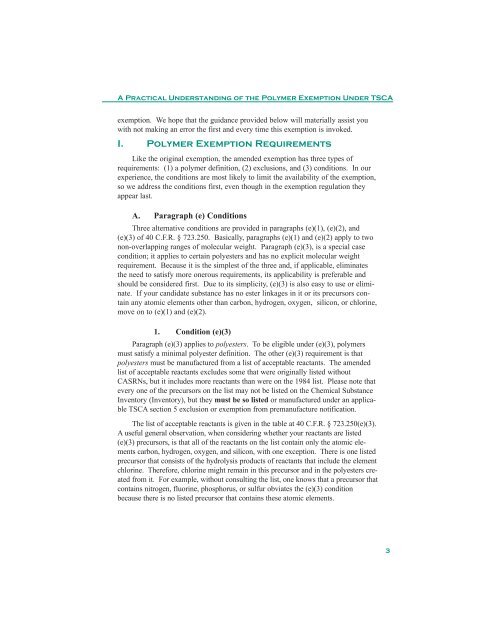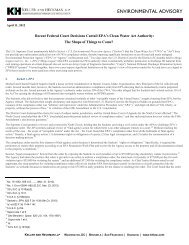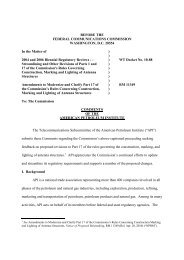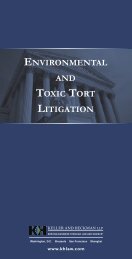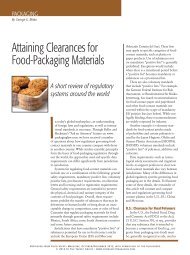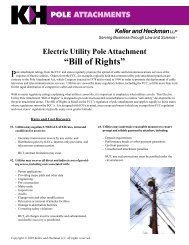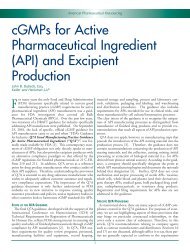A Practical Understanding of the Polymer ... - Keller Heckman
A Practical Understanding of the Polymer ... - Keller Heckman
A Practical Understanding of the Polymer ... - Keller Heckman
Create successful ePaper yourself
Turn your PDF publications into a flip-book with our unique Google optimized e-Paper software.
A <strong>Practical</strong> <strong>Understanding</strong> <strong>of</strong> <strong>the</strong> <strong>Polymer</strong> Exemption Under TSCA<br />
exemption. We hope that <strong>the</strong> guidance provided below will materially assist you<br />
with not making an error <strong>the</strong> first and every time this exemption is invoked.<br />
I. <strong>Polymer</strong> Exemption Requirements<br />
Like <strong>the</strong> original exemption, <strong>the</strong> amended exemption has three types <strong>of</strong><br />
requirements: (1) a polymer definition, (2) exclusions, and (3) conditions. In our<br />
experience, <strong>the</strong> conditions are most likely to limit <strong>the</strong> availability <strong>of</strong> <strong>the</strong> exemption,<br />
so we address <strong>the</strong> conditions first, even though in <strong>the</strong> exemption regulation <strong>the</strong>y<br />
appear last.<br />
A. Paragraph (e) Conditions<br />
Three alternative conditions are provided in paragraphs (e)(1), (e)(2), and<br />
(e)(3) <strong>of</strong> 40 C.F.R. § 723.250. Basically, paragraphs (e)(1) and (e)(2) apply to two<br />
non-overlapping ranges <strong>of</strong> molecular weight. Paragraph (e)(3), is a special case<br />
condition; it applies to certain polyesters and has no explicit molecular weight<br />
requirement. Because it is <strong>the</strong> simplest <strong>of</strong> <strong>the</strong> three and, if applicable, eliminates<br />
<strong>the</strong> need to satisfy more onerous requirements, its applicability is preferable and<br />
should be considered first. Due to its simplicity, (e)(3) is also easy to use or eliminate.<br />
If your candidate substance has no ester linkages in it or its precursors contain<br />
any atomic elements o<strong>the</strong>r than carbon, hydrogen, oxygen, silicon, or chlorine,<br />
move on to (e)(1) and (e)(2).<br />
1. Condition (e)(3)<br />
Paragraph (e)(3) applies to polyesters. To be eligible under (e)(3), polymers<br />
must satisfy a minimal polyester definition. The o<strong>the</strong>r (e)(3) requirement is that<br />
polyesters must be manufactured from a list <strong>of</strong> acceptable reactants. The amended<br />
list <strong>of</strong> acceptable reactants excludes some that were originally listed without<br />
CASRNs, but it includes more reactants than were on <strong>the</strong> 1984 list. Please note that<br />
every one <strong>of</strong> <strong>the</strong> precursors on <strong>the</strong> list may not be listed on <strong>the</strong> Chemical Substance<br />
Inventory (Inventory), but <strong>the</strong>y must be so listed or manufactured under an applicable<br />
TSCA section 5 exclusion or exemption from premanufacture notification.<br />
The list <strong>of</strong> acceptable reactants is given in <strong>the</strong> table at 40 C.F.R. § 723.250(e)(3).<br />
A useful general observation, when considering whe<strong>the</strong>r your reactants are listed<br />
(e)(3) precursors, is that all <strong>of</strong> <strong>the</strong> reactants on <strong>the</strong> list contain only <strong>the</strong> atomic elements<br />
carbon, hydrogen, oxygen, and silicon, with one exception. There is one listed<br />
precursor that consists <strong>of</strong> <strong>the</strong> hydrolysis products <strong>of</strong> reactants that include <strong>the</strong> element<br />
chlorine. Therefore, chlorine might remain in this precursor and in <strong>the</strong> polyesters created<br />
from it. For example, without consulting <strong>the</strong> list, one knows that a precursor that<br />
contains nitrogen, fluorine, phosphorus, or sulfur obviates <strong>the</strong> (e)(3) condition<br />
because <strong>the</strong>re is no listed precursor that contains <strong>the</strong>se atomic elements.<br />
3


